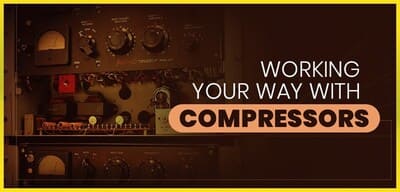Working your way with compressors
While the term ‘compression’ may seem complex and the reason for using a compressor may be unclear to most people using one for the first time, compression isn’t that difficult of a concept, once you understand the basics behind it. Before we begin trying to understand audio compression, we need to know what ‘dynamic range’ of audio is. The dynamic range of audio can simply be defined as the ratio of the amplitude (aka level) of the loudest possible signal to the noise floor (which is nothing more than the signal created by summing all the noise sources and unwanted signals in a system). So, in layman terms, anything that lies within the loudest and quietest parts of a piece of audio is considered it’s dynamic range. Compressors are devices that alter the dynamic range of audio. They achieve this by ‘compressing’ the audio that goes through them, generally so that the overall level of the audio can be raised. The first look at a compressor may scare most first-time users because of all the different knobs and buttons, but the basic parameters of most compressors are the same. They are attack, release, ratio, threshold, knee, and gain. Attack (also known as the attack time) is the amount of time a compressor takes to kick in and reduce the gain of the audio signal being sent through it.


The release is the amount of time it takes for the signal to go from the compressed state back to its original state. The threshold is the level above which the compressor will engage and compress the audio signal being sent through it. The ‘knee’ defines how the compressor moves between the attenuated (compressed) and non-attenuated (uncompressed) audio signals. Most compressors have a ‘soft-knee’ and ‘hard-knee’ setting. A soft-knee allows for a gradual, smoother transition, whereas the hard-knee allows for a more sudden, harsher transition. Ratio (also known as compression ratio) defines the amount of compression (attenuation) to be applied to the audio passing through it.
Compression ratios are expressed in decibels(dB). A ratio of 1:1 represents no attenuation. A ratio of 2:1 means that the amplitude of the audio passing through the compressor will be attenuated down to 1 decibel if it exceeds the threshold by 2 decibels. A ratio of infinity to one is generally used to ensure that the signal never exceeds the amplitude of the threshold (and thus, by definition, may be considered as limiting). Gain (also known as make-up gain or output gain) is used to compensate for the attenuation of the audio done by the compressor.
Optical compressors like the LA-2A by Teletronix do not have attack and release times and modulate the dynamics of the audio signal passing through it by using a light source and optical cell. The light source increases light emission with the increase in the level of the audio signal passing through it, which causes the optical cell to attenuate the level of the audio signal accordingly. Hopefully, this piece will have helped you understand compressors better, and using a compressor won’t feel as daunting anymore.


CATEGORIES
Are you aspiring to become a proficient Sound Engineering professional?
Look no further; we are committed to nurturing the potential of young minds. Are you ready to enhance your skills?

